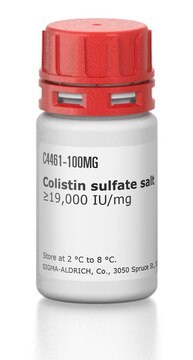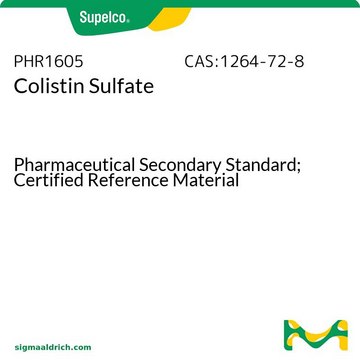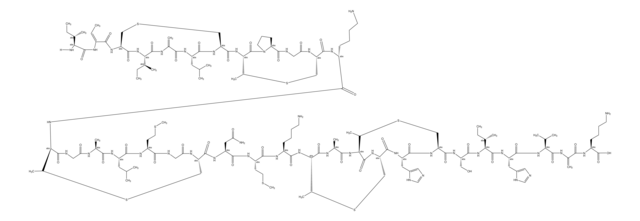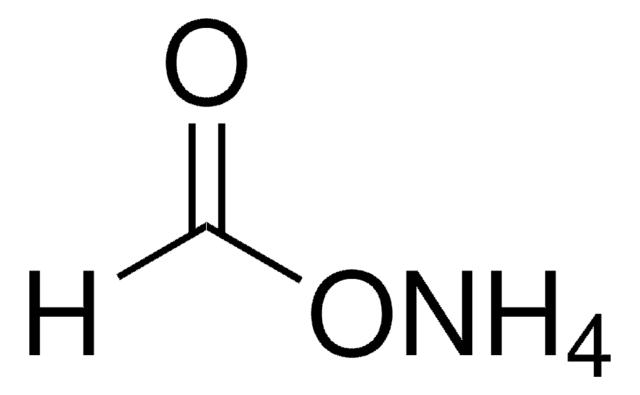C1511
Metanossulfonato sódico de colistina
~11,500 U/mg
Sinônimo(s):
Colimicina sódica, Polimixina E sódica, Ácido metanossulfônico derivado de polimixina E
About This Item
Produtos recomendados
forma
powder
atividade específica
~11,500 U/mg
solubilidade
H2O: 50 mg/mL
espectro de atividade do antibiótico
Gram-negative bacteria
Modo de ação
cell membrane | interferes
temperatura de armazenamento
2-8°C
cadeia de caracteres SMILES
[Na+].[Na+].[Na+].[Na+].[Na+].CS([O-])(=O)=O.CS([O-])(=O)=O.CS([O-])(=O)=O.CS([O-])(=O)=O.CS([O-])(=O)=O.CCC(C)CCCCC(=O)N[C@@H](CCN)C(=O)N[C@@H](C(C)O)C(=O)N[C@@H](CCN)C(=O)N[C@H]1CCNC(=O)[C@@H](NC(=O)[C@H](CCN)NC(=O)[C@@H](CCN)NC(=O)[C@H](CC(C)C)NC(=O)[C@@H](CC(C)C)NC(=O)[C@H](CCN)NC1=O)C(C)O
InChI
1S/C53H100N16O13.5CH4O3S.5Na/c1-9-30(6)12-10-11-13-41(72)60-33(14-20-54)48(77)69-43(32(8)71)53(82)65-36(17-23-57)45(74)64-38-19-25-59-52(81)42(31(7)70)68-49(78)37(18-24-58)62-44(73)34(15-21-55)63-50(79)39(26-28(2)3)67-51(80)40(27-29(4)5)66-46(75)35(16-22-56)61-47(38)76;5*1-5(2,3)4;;;;;/h28-40,42-43,70-71H,9-27,54-58H2,1-8H3,(H,59,81)(H,60,72)(H,61,76)(H,62,73)(H,63,79)(H,64,74)(H,65,82)(H,66,75)(H,67,80)(H,68,78)(H,69,77);5*1H3,(H,2,3,4);;;;;/q;;;;;;5*+1/p-5/t30?,31-,32-,33+,34-,35+,36+,37+,38+,39+,40-,42+,43+;;;;;;;;;;/m1........../s1
chave InChI
WSDSONZFNWDYGZ-BKFDUBCBSA-I
Procurando produtos similares? Visita Guia de comparação de produtos
Categorias relacionadas
Descrição geral
Aplicação
Ações bioquímicas/fisiológicas
Espectro da ação antimicrobiana: Bactérias gram negativas.
Outras notas
Código de classe de armazenamento
11 - Combustible Solids
Classe de risco de água (WGK)
WGK 3
Ponto de fulgor (°F)
Not applicable
Ponto de fulgor (°C)
Not applicable
Equipamento de proteção individual
Eyeshields, Gloves, type N95 (US)
Certificados de análise (COA)
Busque Certificados de análise (COA) digitando o Número do Lote do produto. Os números de lote e remessa podem ser encontrados no rótulo de um produto após a palavra “Lot” ou “Batch”.
Já possui este produto?
Encontre a documentação dos produtos que você adquiriu recentemente na biblioteca de documentos.
Nossa equipe de cientistas tem experiência em todas as áreas de pesquisa, incluindo Life Sciences, ciência de materiais, síntese química, cromatografia, química analítica e muitas outras.
Entre em contato com a assistência técnica






